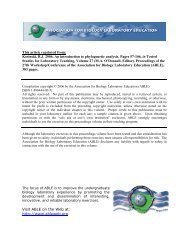Lumbriculus variegatus - Association for Biology Laboratory Education
Lumbriculus variegatus - Association for Biology Laboratory Education
Lumbriculus variegatus - Association for Biology Laboratory Education
Create successful ePaper yourself
Turn your PDF publications into a flip-book with our unique Google optimized e-Paper software.
Pulsation rate of blackworms 141<br />
• In humans, caffeine inhibits the enzyme phosphodiesterase, thus allowing cAMP levels to go up<br />
and ultimately increasing the heart rate. In blackworms, it is not clear if the increase in pulsation<br />
rate due to caffeine is a direct or indirect effect.<br />
• Alcohol acts as an ion channel blocker, thus decreasing the pulsation rate of the dorsal vessel.<br />
Blackworm responses to solutions<br />
• Response to caffeine – At low concentrations, worms may clump. As concentration increases,<br />
worms become very active. They may curl up and stretch out at higher concentrations.<br />
Pulsation rate will increase. Most worms recover within 15 minutes and all recover within one<br />
day.<br />
• Response to alcohol – Worms will become inactive as concentration increases and will be less<br />
likely to clump. Worms may straighten out, with their ends curled, in higher concentrations.<br />
They will not be able to swim as well. Their pulsation rate will decrease. Worms at the lower<br />
concentrations will begin to recover within 15 minutes. Most all worms will recover within one<br />
day.<br />
• Response to nicotine – Worms become more active, but do not clump. At moderate doses, the<br />
worms may be less active and twitch. In high doses (0.1 mM), paralysis (worm will be stretched<br />
out and motionless) may occur. The pulsation rate may not show an increase at the lowest<br />
concentration, but will increase at the middle and high concentrations. Most worms begin to<br />
recover within 15 minutes and all recover within one day.<br />
Tips <strong>for</strong> Instructors<br />
• Suggestion <strong>for</strong> beginning the lab (to engage)o<br />
Have the students locate their pulse and ask them what they are sensing. Then, ask them<br />
how they could change the rate of their pulse. Once they start bringing up many types of<br />
drugs, ask them how drugs might affect the rate.<br />
• When students first obtain their worms, have them place them in a weigh boat with just spring<br />
water. Tell them to take some time making initial observations – which end is the tail end? How<br />
do you know? What is the behavior of the worm? Does the worm swim? How? How is the<br />
worm responding to its new environment? Etc. Lead a class discussion about their observations.<br />
• To get the worm to stay in the well and to coax it into a good position <strong>for</strong> viewing, gently use the<br />
widget or a piece of hair.<br />
• Have one person view worm and count pulses while the other keeps track of time. Switch roles<br />
often and make sure both students are relatively consistent when completing the baseline rate<br />
count.<br />
• Students can mix their own dilutions of the stock solution, or you can have dilutions already<br />
made <strong>for</strong> them. They could also try other dilutions than just the ones recommended in the<br />
recipes in Appendix A.<br />
• Tell students to be careful not to transfer liquid from one container to the next as they move the<br />
worms. Students also need to discern between pipets to reduce contamination.<br />
• Wells need to be rinsed thoroughly with distilled water between worms
















